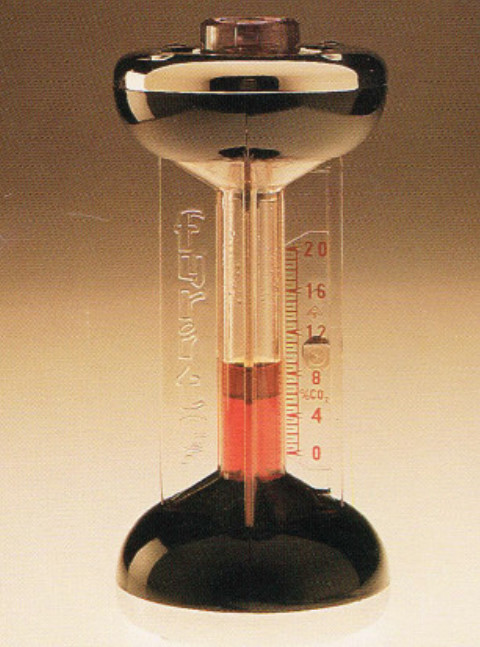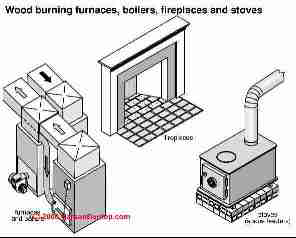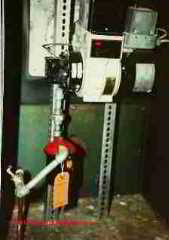 What is AFUE
What is AFUE
Definition & Calculation of
Annual Fuel Utilization Efficiency
- POST a QUESTION or COMMENT about AFUE and heating system efficiency ratings, measurement, and improvement
This article gives a definition of AFUE and explains AFUE (Annual Fuel Utilization Efficiency) or heating system efficiency ratings and numbers.
The articles at this website describe the basic components of a home heating system, how to find the rated heating capacity of an heating system by examining various data tags and components, how to recognize common heating system operating or safety defects, and how to save money on home heating costs.
InspectAPedia tolerates no conflicts of interest. We have no relationship with advertisers, products, or services discussed at this website.
- Daniel Friedman, Publisher/Editor/Author - See WHO ARE WE?
How is heating boiler efficiency or economy measured? What does boiler AFUE mean?
How is heating boiler efficiency or economy measured? What does boiler AFUE mean?
In short, the AFUE (Annual Fuel Utilization Efficiency) tells you,
for each dollar you spend on energy for heating by gas, oil, or another fuel, just how much of your dollar shows up inside the occupied space of your building as heat.
Here's a very rough example: if the AFUE number for your heater is 80%, that means that for every dollar you spend on heat, twenty cents "goes up the chimney" or is lost in various other ways, and eighty cents of each heating dollar shows up in your occupied space as heat.
[Click to enlarge any image]
Each model of heating boiler or furnace is assigned an AFUE number. Our page top sketch of a high efficiency furnace is provided courtesy of Carson Dunlop Associates Associates.
At left we illustrate a high efficiency gas furnace - expected to have a high AFUE number. Sketch courtesy of Carson Dunlop Associates Associates.
Also see this sketch of a high efficiency condensing furnace and this high efficiency pulse combustion heating system.
AFUE is an abbreviation for Annual Fuel Utilization Efficiency. In short, the AFUE tells you, for each dollar you spend on energy for heating by gas, oil, or another fuel, just how much of your dollar shows up inside the occupied space of your building as heat. Higher AFUE is better.
If your boiler or furnace or steam boiler has an AFUE rating of 90, that means that for every dollar you spend on fuel, 90 cents worth of heat is delivered into your building. The remaining 10 cents is lost in inefficiency such as heat that escapes up the chimney along with the products of combustion.
How is the Efficiency of a Gas or Oil Fired Boiler Actually Measured?
 The combustion efficiency of an oil or gas fired heater is in effect a measurement of how effectively the heating appliance is converting the chemical energy of its fuel (oil or gas boilers or oil, gas or electric furnaces) into heat. Combustion air, burner adjustments, temperatures and other factors in the heater's design determine the actual efficiency of its burner.
The combustion efficiency of an oil or gas fired heater is in effect a measurement of how effectively the heating appliance is converting the chemical energy of its fuel (oil or gas boilers or oil, gas or electric furnaces) into heat. Combustion air, burner adjustments, temperatures and other factors in the heater's design determine the actual efficiency of its burner.
The output of these heating appliances will be in the form of heated air (furnaces), heated water (hydronic or "hot water" boilers), or steam (steam boilers).
Details of the test procedure used to determine AFUE for a heating appliance are specified in the U.S. by ASHRAE Standard 103 cited below.
You'll notice in ASHRAE 103 that the standard writers took care to note that the "factory" AFUE cannot be assumed to be the actual AFUE for a specific installation in the field.
But efficiency is usually measured as well in the field at installed heating appliances as a final step in the annual cleaning and tune-up of the heater. In our opinion this is likelty to be a more accurate measurement than the factory specified AFUE as it is measuring the actual heater in-situ, even though those results cannot be extended to other installations whose site conditions will be different.
A technician actually determines the combustion efficiency of the heater by using instruments to measure both the operating temperature (measured in the exhaust gases in the flue) and the carbon dioxide level (CO2) in the exhaust gas exiting the heater in the breech - an area in the flue vent connector between the surface of the the heater and the draft regulator (if one is present there).
The heater has to have been on or operating long enough to have reached full operating temperature or to be in "steady state" condition.
 at OIL BURNER CO2 TEST you can see an example of this procedure for oil burner fired heating appliances.
at OIL BURNER CO2 TEST you can see an example of this procedure for oil burner fired heating appliances.
Watch out: do not make heating appliance measurements before the heater has been on long enough to have reached steady state; that's often about 5 minutes, and it's easy enough to determine by simply monitoring the flue temperature.
When the flue temperature stops increasing the heater is at steady state. This is critical because combustion will be incomplete and thus inefficient when the heating appliance and its combustion chamber have not reached full operating temperature.
Given the CO2 measurement the technician simply looks up the corresponding fuel efficiency number (a percentage) in a table for the fuel being used (oil or gas).
Details of this procedure and charts describing key relationships like the important effects of both inlet water temperature and return water temperature on the efficiency of a condensing boiler, were given by Durkin (2006).
Below in our citations the Cold Climate Housing Research Center has published an excellent article reviewing AFUE and how it is obtained and used for buildings in a cold climate.
Research & Standards on AFUE Definition, Measurement Standards, & Heating System Efficiency Measurements
- CCHRC, "AFUE Annual Fuel Utilization Efficiency A REVIEW for COLD CLIMATE APPLICABILITY", Cold Climate Housing Research Center, 1000 Fairbanks Street Fairbanks AK 99709 USA, Tel: (907) 457-3454, (2013), Website: http://www.cchrc.org, retrieved 2017/05/23, original source: http://www.cchrc.org/sites/default/files/docs/afue_final.pdf Website Excerpt about the CCHRC:
The Cold Climate Housing Research Center is an industry-based nonprofit corporation created to facilitate the development, use, and testing of energy-efficient, durable, healthy, and cost-effective building technologies for people living in cold climates. - ANSI/ASHRAE Standard 103. (2013). Method of Testing for Annual Fuel Utilization Efficiency of Residential
Central Furnaces and Boilers. Atlanta: ANSI/ASHRAE. Website: http://spc103.ashraepcs.org/ Description:
1. PURPOSE: The purpose of this standard to provide procedures for determining the annual fuel utilization efficiency of residential central furnaces and boilers.
2. SCOPE:
2.1 This standard includes:
(a) a test method for cyclic and part-load performance,
(b) methods for interpolating and extrapolating test data, and
(c) calculation procedures for establishing seasonal performance.
2.2 This standard applies to central furnaces with inputs less than 225,000 Btu/h and boilers with inputs less than 300,000 Btu/h, having gas, oil or electric input, intended for use in residential applications. This standard also applies to furnaces contained within the same cabinet with central air conditioners that have rated cooling capacities of 65,000 Btu/h or less.
2.2.1 This standard applies to equipment that utilizes single-phase electric current or low-voltage DC current.
2.2.2 This standard covers the effectiveness of electrical/mechanical stack dampers only.
2.3 The test procedures are intended to be used to compare energy consumption measures of various furnace and boiler models. They are not intended to provide an absolute measure of performance in any specific installation configuration since the effects of heating system installation variables are not fully taken into account. - Butcher, T. (2011). Performance of Combination Hydronic Systems. ASHRAE Journal , 36-41.
- Chi, J., & Kelly, G. (1978). A method for estimating the seasonal performance of residential gas and oil-fired heating systems. ASHRAE Transactions 84 , 405-421.
- Durkin, T. (2006). Boiler System Efficiency. ASHRAE Journal , 51-57.
- "FURNACES & BOILERS, AFUE & EFFICIENCY SUGGESTIONS", [PDF] U.S. Department of Energy, Office of Energy Efficiency & Renewable Energy Forrestal Building 1000 Independence Avenue, SW Washington, DC 20585 USA, retrieved 2017/05/23, original source: https://energy.gov/energysaver/furnaces-and-boilers
What is the Reliability & Accuracy of Heating System Efficiency Ratings - AFUE?
 AFUE is not the whole story of heating cost efficiency. A high-efficiency heating system that has not been cleaned and serviced may be running poorly and wasting money.
AFUE is not the whole story of heating cost efficiency. A high-efficiency heating system that has not been cleaned and serviced may be running poorly and wasting money.
In fact, an 85% AFUE heating boiler that has not been cleaned might be running at an efficiency much lower, perhaps 65%.
Furthermore, if your building is drafty or poorly insulated, you may be delivering heat at high efficiency but losing it from the building much faster than necessary.
Really? Well while AFUE is important in comparing two heating appliances that use the same fuel, the cost of yoru fuel and the general efficiency range of your fuel choice (oil, gas, propane, wood, electric) has a greater effect on othe actual annual cost to heat your building than the heater's AFUE rating, and
These articles can help with a more complete approach to saving money on heat:
- HEATING COST SAVINGS METHODS - what steps can we take to increase the efficiency of the heating system installed at a building and what are the priorities of steps to take to save on heating cost?
- HEAT LOSS RATE CALCULATIONS - R, U, & K VALUES - how do we calculate heat loss rates for a building
- HEAT LOSS INDICATORS - what can we see by visual inspection that indicates that a building is losing heat?
- HEATING COST FUEL & BTU COST TABLES - fuel costs per BTU or other heating units.
- INSULATION IDENTIFICATION GUIDE - how to reduce heating costs by clever installation of insulation
- ENERGY SAVINGS in BUILDINGS - our complete article series on saving on energy consumption & costs in buildings
Current AFUE Requirements for Heating Equipment in Canada & the U.S. ?

- In the United States, the U.S. Department of Energy has specified that effective in 2012:
The minimum AFUE for heating furnaces (warm air heat) sold in the U.S. must have an AFUE of 78% or better for non-condensing fossil-fueled furnaces
The minimum AFUE for gas-fired hot water (hydronic) boilers is 82%
The minimum AFUE for oil-fired hot water boilers is 84% - In Canada, National Resources Canada (NRC) as of 2009 specifies that gas furnaces manufactured after 31 December 23 2009 must have an AFUE of 90%. Kudos to the Canadian NRC.
Typical AFUE Ratings for Heater Types & Various Fuels
Typical AFUE Percentages by Fuel, Heater Type |
||
Fuel |
Furnace or Boiler Type |
Typical AFUE Rating |
| No. 2 Heating Oil | Pre-1970 cast-iron (boiler, probably with older type oil burner) | 60% (4) |
| Retention head burner, probably high speed motor | 70–78% | |
| Mid efficiency | 83–89% | |
| Electricity | Central or baseboard | 100% |
| Geothermal heat pump | seeCOP Coefficient of Performance | |
| Air-source heat pump | see HSPF Heating System Performance Factor | |
| Natural Gas | Standard efficiency | 78–84% |
| Condensing | 90–97% | |
| Propane | Standard efficiency | 79–85% |
| Condensing | 88–95% | |
| Wood (firewood) | Conventional | 45–55% |
| Advanced | 55–65% | |
| State-of-the-Art | 75–90% | |
Notes to the Table Above
- Adapted from Wikipedia, "Annual fuel utilization efficiency", retrieved 2017/05/23, original source: https://en.wikipedia.org/wiki/Annual_fuel_utilization_efficiency , Wikipedia provided background information about some AFUE topics discussed at this website provided. Because Wikipedia and other website entries can be amended in real time, we cite the retrieval date of such citations and we do not assert that the information found there is always authoritative.
- These Wikipedia general AFUE numbers do not distinguish between heat media (boiler vs furnace or water, steam, air) and do not reflect the particular AFUE that will be measured at a specific residential building's heating furnace or boiler.
- See HEATING COST FUEL & BTU COST TABLES where we include actual fuel costs per BTU or other heating units.
- The author [DF] has been able to raise the efficiency of a pre-1970 cast iron heating boiler from 60% up to 76% by installing a new high-speed oil burner and adjusting the burner mount location - photo shown here.
We replaced an old 1725 rpm burner with a high speed Beckett 3450 rpm oil burner and we moved the oil burner up to fire through the upper door of a cast iron heating boiler that had originally been coal fired and that was installed in this Poughkeepsie NY home in 1900.
Details are at OIL BURNERS - CMHC, A Guide to Residential Wood Heating [PDF] (2008 ed.), ISBN 978-0-660-19848-4, Canada Mortgage and Housing Corporation, ed. (2008) retrieved 2017/05/23, original source http://publications.gc.ca/collections/collection_2009/schl-cmhc/NH15-436-2008E.pdf
- CMHC, Residential Earth Energy Systems, Buyer's Guide [PDF], Canada Mortgage and Housing Corporation, ed. (2002) ISBN 0-662-30980-4 retrieved 2017/05/23, original source http://publications.gc.ca/collections/Collection/M92-236-
Excerpt:
The aim of this publication is to help readers with the decision to purchase and install an Earth Energy System (EES). The subject is complex, and the decision depends on many variables.
As a result, this guide cannot provide enough information to evaluate a potential system fully, nor is it a “how-to” manual for the installation, operation and maintenance of a system.
Prospective buyers should thus seek out qualified advice and assistance to supplement the information provided here.
They should also contact local utility and government agencies to ensure that their new system will meet all relevant electrical codes, as well as building and site regulations.
Other Heating System Performance Measurements & Standards
Also see our definition of HSPF, SEER, and other measurements found at SEER RATINGS & OTHER DEFINITIONS [live linke just below] or select a topic from the closely-related articles below, or see the complete ARTICLE INDEX.
...
Continue reading at APPLIANCE EFFICIENCY RATINGS or select a topic from the closely-related articles below, or see the complete ARTICLE INDEX.
Or see these
Recommended Articles
- DEFINITION of HEATING, COOLING & INSULATION TERMS
- ENERGY SAVINGS PRIORITIES
- HEATING COST FUEL & BTU COST TABLES
- HEATING COST SAVINGS METHODS
- SEER RATINGS & OTHER DEFINITIONS
Suggested citation for this web page
AFUE DEFINITION, RATINGS at InspectApedia.com - online encyclopedia of building & environmental inspection, testing, diagnosis, repair, & problem prevention advice.
Or see this
INDEX to RELATED ARTICLES: ARTICLE INDEX to HEATING SYSTEMS
Or use the SEARCH BOX found below to Ask a Question or Search InspectApedia
Ask a Question or Search InspectApedia
Try the search box just below, or if you prefer, post a question or comment in the Comments box below and we will respond promptly.
Search the InspectApedia website
Note: appearance of your Comment below may be delayed: if your comment contains an image, photograph, web link, or text that looks to the software as if it might be a web link, your posting will appear after it has been approved by a moderator. Apologies for the delay.
Only one image can be added per comment but you can post as many comments, and therefore images, as you like.
You will not receive a notification when a response to your question has been posted.
Please bookmark this page to make it easy for you to check back for our response.
IF above you see "Comment Form is loading comments..." then COMMENT BOX - countable.ca / bawkbox.com IS NOT WORKING.
In any case you are welcome to send an email directly to us at InspectApedia.com at editor@inspectApedia.com
We'll reply to you directly. Please help us help you by noting, in your email, the URL of the InspectApedia page where you wanted to comment.
Citations & References
In addition to any citations in the article above, a full list is available on request.
- [1] ...
- Our recommended books about building & mechanical systems design, inspection, problem diagnosis, and repair, and about indoor environment and IAQ testing, diagnosis, and cleanup are at the InspectAPedia Bookstore. Also see our Book Reviews - InspectAPedia.
- In addition to citations & references found in this article, see the research citations given at the end of the related articles found at our suggested
CONTINUE READING or RECOMMENDED ARTICLES.
- Carson, Dunlop & Associates Ltd., 120 Carlton Street Suite 407, Toronto ON M5A 4K2. Tel: (416) 964-9415 1-800-268-7070 Email: info@carsondunlop.com. Alan Carson is a past president of ASHI, the American Society of Home Inspectors.
Thanks to Alan Carson and Bob Dunlop, for permission for InspectAPedia to use text excerpts from The HOME REFERENCE BOOK - the Encyclopedia of Homes and to use illustrations from The ILLUSTRATED HOME .
Carson Dunlop Associates provides extensive home inspection education and report writing material. In gratitude we provide links to tsome Carson Dunlop Associates products and services.

